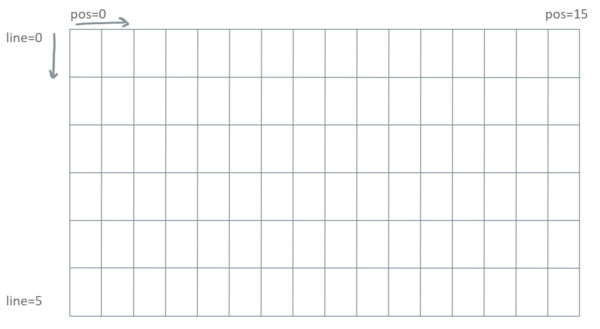OLED LCD Display: Difference between revisions
Jump to navigation
Jump to search
No edit summary |
|||
| Line 81: | Line 81: | ||
oled.show() | oled.show() | ||
</syntaxhighlight> | </syntaxhighlight> | ||
[[File:DisplayPixel.PNG|600px]] | |||
[[File:DisplayLinePos.PNG|600px]] | |||
= A small Program in MicroPython = | = A small Program in MicroPython = | ||
Revision as of 17:15, 20 August 2020
Description
See also Tutorial Display
We use ssd1306.py
How to connect it electrically
Text
Image(s)
How to control it in MicroPython
from machine import Pin, I2C
from ssd1306 import SSD1306_I2C
i2c = I2C(scl=Pin(15), sda=Pin(4))
pin16 = Pin(16, Pin.OUT)
pin16.on()
oled_width = 128
oled_height = 64
oled = SSD1306_I2C(oled_width,oled_height,i2c)
# switch the display off, but it's still active
oled.poweroff()
# switch the display on again
oled.poweron()
# contrast in range 0-255 (0=darker)
oled.contrast(contrast)
# invert in True/False
oled.invert(invert)
# content will be shown, has to be called when something changes
oled.show()
# Graphics
# fill the screen in color c (0=dark, 1=bright)
oled.fill(c)
# set pixel at position x,y to color c
oled.pixel(x,y,c)
# returns color of pixel x,y
oled.pixel(x,y)
# draws a horizontal line from x,y, length=w in color c
oled.hline(x,y,w,c)
# draws a vertical line from x,y, length=w in color c
oled.vline(x,y,w,c)
# draws a line from x1,y1 to x2,y2 in color c
oled.line(x1,y1,x2,y2,c)
# draws a rectangle at position x,y with width=w and height=h in color c
oled.rect(x,y,w,h,c)
# draws a filled rectangle at position x,y with width=w and height=h in color c
oled.fill_rect(x,y,w,h,c)
# Text
# set text s at pixel x,y
oled.text(s,x,y,c)
# line = line number (0-5)
# pos = horizontal position (0-15)
def text_line(text, line, pos=0):
x = 10*pos
y = line*11
oled.text(text,x,y)
oled.show()
# don't forget to show!
oled.show()A small Program in MicroPython
# todo
# code goes heretext
image(s)
Related Tutorial Videos
change to the right video
Background
text
image(s)
